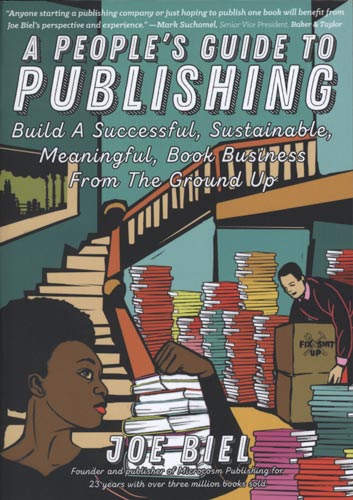A People’s Guide to Publishing

Build a Successful, Sustainable, Meaningful, Book Business from the Ground Up
Joe Biel
December 2018
Vivian Wagner
Joe Biel’s A People’s Guide to Publishing is an inspirational and practical guidebook for anyone interested in starting and sustaining a publishing company. Biel, founder of Microcosm Publishing, a small, Portland, Oregon-based press, understands how to build a publishing company from scratch, and with his conversational style he leads readers through every stage of this process and beyond.
Joe Biel’s A People’s Guide to Publishing is an inspirational and practical guidebook for anyone interested in starting and sustaining a publishing company. Biel, founder of Microcosm Publishing, a small, Portland, Oregon-based press, understands how to build a publishing company from scratch, and with his conversational style he leads readers through every stage of this process and beyond.
Beneath all the details about business plans, marketing, paper choices, printing styles, distributors, and contracts, A People’s Guide to Publishing has a radical, DIY, punk-rock philosophy that echoes that of Microcosm Publishing itself. Publishing is a way to get books out there that need to be read, and Biel offers spirited advice about how to get that done.
Running a publishing company, for Biel, is about more than just printing books. It’s about building a movement. As he says:
a publisher has the vision to see a different world and the determination and grit to make it happen. The best part of publishing is that you get to be who you are, open and honest on the page. Make your publishing an honest, fundamental expression of yourself and your interests.
Some of the first advice in the book, therefore, is to “find your meaning and purpose,” since, “your statement of purpose will ground you during uncertain times, hard decisions, and financial peril.” He spends a lot of time in the book encouraging would-be publishers to explore their interests and passions and, ultimately, to develop their own particular niche. Small publishers, he says, do best when they have their own identity: “as a small publisher, you don’t have enough of a marketing budget to market yourself as plain. If you do, cut your marketing budget and go back to reflecting on what you care the most about.”
Having a niche, he says, also helps to define your audience and potential customers:
most independent publishers focus on a single subject: business, mysteries, photography, science fiction, children’s books, self-help, adult coloring books, politics, or literary fiction. Having a specific focus simplifies many aspects of being a publisher. Once readers find one of your titles, it’s easier for them to latch onto the rest of your catalog, and it’s more likely that they will be interested in other books that you publish.
Once you sort out what kind of publisher you want to be and what kinds of books you want to publish, you’ll have to focus on things like finding authors, locating printers, designing books, choosing distributors, marketing your catalog, and focusing on your company’s long-term financial sustainability. Biel has detailed and specific information about each of these topics and many more, introducing readers to all the terms, concepts, and skills they’ll need to make their publishing dream a reality. The book might be rooted in countercultural impulses, in other words, but it’s full of down-to-earth business sense.
One of the most interesting things about the book is its emphasis on finding and exploiting non-traditional venues for selling books—like hardware stores, gift shops, or gas stations. It also makes the financial case for doing most online sales through the publisher’s own website, rather than Amazon, and for seeking out unusual book sales opportunities like festivals or other events. The spirit behind A People’s Guide to Publishing is one of creativity and flexibility—experimenting with strategies and techniques in order to find whatever works to get your books into the hands of readers.
At the end of the book, Biel provides an appendix full of even more detailed information, including lists of full-service trade distributors and book wholesalers, sample screening interview questions for interns and employees, a sample style guide, and a sample publishing contract. This is the kind of nuts-and-bolts information that’s particularly useful for new publishers who might not know where to begin when it comes to the daily practicalities of running a company.
The book’s final chapter, called “The Future of Publishing,” offers a real-world pep-talk about how, despite all the potential difficulties and pitfalls, there’s never been a better time to start a small publishing company. As he says:
if you can figure out how to sustain your expenses while selling 3,000 to 5,000 copies of each book, you can seize a piece of this dream. If you find a vacant niche, follow your passions, understand them, and publish great work consistently, you’ll have a bright future. And you get to touch people’s lives and have the best job. That’s the biggest victory of them all.
These final words capture the spirit and intent of this book, which is a compendium of both the practical and the inspirational. Even for those not planning on starting a publishing company any time soon, this book is a spirited and engaging exploration of the future of the printed word.




